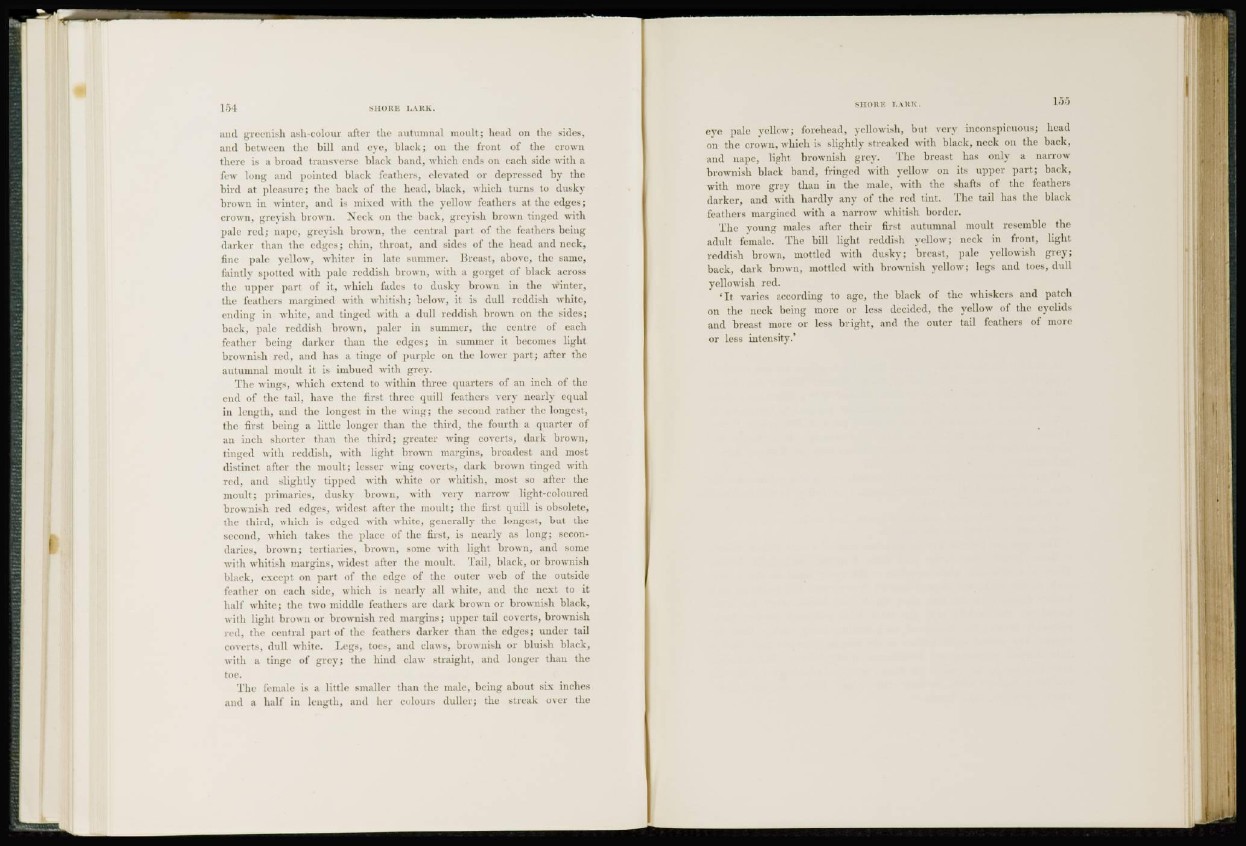
154 SHORE LARK.
and greenish ash-colour after the autumnal moult; head on the sides,
and between the bill and eye, black; on the front of the crown
there is a broad transverse black hand, which ends on each side with a
few long and pointed black feathers, elevated or depressed by the
bird at pleasure; the back of the head, black, which turns to dusky
brown in winter, and is mixed with the yellow feathers at the edges;
crown, greyish brown. Neck on the back, greyish brown tinged with
pale red; nape, greyish brown, the central part of the feathers being
darker than the edges; chin, throat, and sides of the head and neck,
fine pale yellow, whiter in late summer. Breast, above, the same,
faintly spotted with pale reddish brown, with a gorgel of black across
the upper part of it. which fades to dusky brown in the winter,
the feathers margined with whitish; below, it is dull reddish white,
ending in white, and tinged with a dull reddish brown on the sides;
back, pale reddish brown, paler in summer, the centre of each
feather being darker than the edges; in summer it becomes light
brownish red, and has a tinge of purple on the lower part; after the
autumnal moult it is imbued with grey.
The wings, winch extend to within three quarters of an inch of the
end of the tail, have the first three quill feathers very nearly equal
in length, and the longest in the wing; the second rather the longest,
the first being a little longer than the third, the fourth a quarter of
an inch shorter than the third; greater wing coverts, dark brown,
tinged with reddish, with light brown margins, broadest and most
distinct after the moult; lesser wing coverts, dark brown tinged with
red, and slightly tipped with white or whitish, most so after the
moult; primaries, dusky brown, with very narrow light-coloured
brownish red edges, widest after the moult; the first quill is obsolete,
the third, which is edged with white, generally the longest, but the
second, which takes the place of the first, is nearly as long; secondaries,
brown; tcrtiarics, brown, some with light brown, and some
with whitish margins, widest after the moult. Tail, black, or brownish
black, except on part of the edge of the outer web of the outside
feather on each side, which is nearly all white, and the next to it
half white; the two middle feathers arc dark brown or brownish black,
with light brown or brownish red margins; upper tail coverts, brownish
red, the central part of the feathers darker than the edges; under tail
coverts, dull white. Legs, toes, and claws, brownish or bluish black,
with a tinge of grey; the hind claw straight, and longer than the
toe.
The female is a little smaller than the male, being about six inches
and a hall' in length, and her colours duller; the streak over the
SHORE I: IRK . 100
eye pale yellow; forehead, yellowish, but very inconspicuous; head
on the crown, which is slightly streaked with black, neck on the back,
and nape, light brownish grey. The breast has only a narrow
brownish black band, fringed with yellow on its upper part; back,
with more grey than in the male, with the shafts of the feathers
darker, and with hardly any of the red tint. The tail has the black
feathers margined with a narrow whitish border.
The young males after their first autumnal moult resemble the
adult female. The bill light reddish yellow; neck in front, light
reddish brown, mottled with dusky; breast, pale yellowish grey;
back, dark brown, mottled with brownish yellow; legs and t o e s , dull
yellowish red.
' It varies according to age, the black of the whiskers and patch
on the neck being more or less decided, the yellow of the eyelids
and breast more or less bright, and the outer tail feathers of more
or less intensity.'